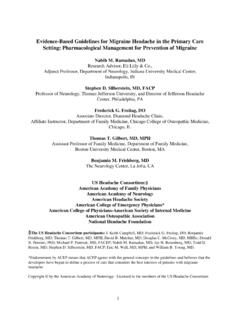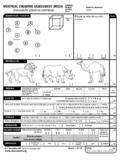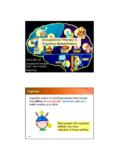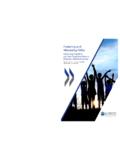Transcription of DETECTION, DIAGNOSIS AND MANAGEMENT OF DEMENTIA
1 DEMENTIA is common in the of persons over age 65 and up to 50 % over 85 have DEMENTIA . AD and MCI differ from normal the ten warning signs of AD. Communicate the warning signs to your community, your colleagues, your patients, and their families. Contact the AAN or the Alzheimer s Association for tools or ideas on how to do so. Identify and monitor Mild Cognitive Impairment patients for progression to is a classification of persons with memory impairment who are not demented (normal general cognitive function; intact activities of daily living). Between 6 and 25% of MCI patients progress to DEMENTIA or AD each year. MCI patients should be evaluated regularly for progression to AD using the assessment tools listed below. Be alert to cognitive impairment in all your for DEMENTIA if cognitive impairment is evidence supports using: General cognitive screening instruments: Mini Mental Status Exam (adjusted for age/education) Memory Impairment Screen Neuropsychological batteriesWeaker evidence supports using: Other general cognitive screening instruments: Kokmen Short Test of Mental Status 7-Minute Screen Interview based techniques: Blessed DEMENTIA Rating Scale CDR IQCODE Brief cognitive assessment instruments*: Clock Drawing Test Time and Change Test*Caution should be used.
2 These tools are limited in scopeAAN Guideline Summary forCLINICIANSDETECTION, DIAGNOSIS ANDMANAGEMENT OF DEMENTIA PRACTICE PARAMETER: detection OF DEMENTIA MILD COGNITIVE IMPAIRMENTThis is a summary of three American Academy of Neurology (AAN) guidelines on DEMENTIA . Although the guidelinesaddress all forms of DEMENTIA , this summary focuses on Alzheimer s disease, for which current evidence is strongestand clearest. The guidelines conclude that AD should be detected and treated early. Patients with Mild CognitiveImpairment should be identified and monitored for progression to AD a likely event. The clinical criteria for diagnosingAD are reliable and valid. Although AD is not curable, there are treatment and care options available today that canmanage symptoms, improve quality of life and delay time to nursing home PARAMETER: DIAGNOSIS OF DEMENTIA The clinical criteria for AD are reliable (DSM-IIIR definition; NINCDS-ADRDA and DSM-IV diagnostic criteria) Vascular DEMENTIA , DEMENTIA with Lewy Bodies and fronto-temporal DEMENTIA should be excluded, but the current diagnostic criteria for those diseases are imperfect.
3 Structural neuroimaging is appropriate to detect lesions which may result in cognitive impairment. The CSF-14-3-3 protein is useful when CJD is suspected and recent stroke or viral encephalitis can be excluded. Evidence supports the following tests in the routine evaluation of the demented patient: Complete blood cell count Serum electrolytes Glucose BUN/creatinine Depression screening Serum B12 levels Thyroid function tests Liver function tests Evidence indicates the following tests should not be included in the routine evaluation of the demented patient Screening for syphilis (unless patient has a specific risk factor, , living in a high-incidence region)1. Memory loss that affects job skills2. Difficulty performing familiar tasks3. Problems with language4.
4 Disorientation to time and place5. Poor or decreased judgment6. Problems with abstract thinking7. Misplacing things8. Changes in mood or behavior9. Changes in personality10. Loss of initiativeUsed with the permission of the Alzheimer s Warning Signs of ADPlease refer to the full guidelines for more information at is an evidence-based educational service of the American Academy of Neurology. It is designed to provide members with evidence-basedguideline recommendations to assist with decision-making in patient care. It is based on an assessment of current scientific and clinical information,and is not intended to exclude any reasonable alternative methodologies. The AAN recognizes that specific patient care decisions are the prerogativeof the patient and the physician caring for the patient, based on the circumstances involved.
5 Physicians are encouraged to carefully review thefull AAN guidelines so they understand all recommendations associated with care of these Montreal Avenue St. Paul, MN (651) 695-1940 Linear or volumetric MR or CT measurement strategies SPECT Genetic testing for DLB or CJD APOE genotyping for AD EEG Lumbar puncture (unless presence of metastatic cancer, suspicion of CNS infection, reactive serum syphilis serology, hydrocephalus, age under 55, rapidly progressive or unusual DEMENTIA , immunosupression, or suspicion of CNS vasculitis) At this time, there is not enough evidence to support or refute the use of the following tests: PET Genetic markers for AD not listed above CSF or other biomarkers for AD Tau mutations in patients with FTD AD gene mutations in patients with FTDPRACTICE PARAMETER.
6 MANAGEMENT OF DEMENTIASTRATEGIES TO IMPROVE FUNCTIONAL PERFORMANCE AND REDUCE PROBLEM BEHAVIORS Treat cognitive symptoms of AD with cholinesterase inhibitors and vitamin E. Consider the use of cholinesteraseinhibitors in mild to moderate patients. Cholinesterase inhibitors may improve quality of life and cognitive functions including memory, thought and reasoning. They are proven effective for people who are mildly to moderately affected by the disease, and are under evaluation in patients with MCI and severe , the early recognition and DIAGNOSIS of Alzheimer's disease is important. Considervitamin E to slow progression of AD; selegiline is also supported, albeit by weaker evidence. Do not prescribe estrogen to treat AD. Treat agitation, psychosis and depression. The patient s paranoia, suspiciousness, combativeness or resistance tomaintaining personal hygiene can seem overwhelming tofamilies and caregivers and significantly impact quality of life.
7 Evidence indicates that several strategies can decrease problem behaviors. If environmental manipulation fails to eliminate agitation or psychosis, use antipsychotics. Selected tricyclics, MAO-B inhibitors and SSRIs should be considered to treat depression. Encourage caregivers to participate in caregiver educational programs and support groups. Short term caregiver educational programs can improve caregiver satisfaction. Long term caregiver educational programs can delay time to nursing home placement for the AD patient. Caregiver training programs, and other support systems (computer support networks, telephone supportprograms, adult day care and other respite programs) may also help delay time to nursing home placement for the AD patient. StrategyStrength Of EvidenceTo improve functional performance Behavior modification, scheduled toileting, prompted voiding to reduce urinary Graded assistance, practice and positive reinforcement to increase functional Low lighting levels, music and simulated nature sounds to improve eating Intensive multi-modality group training may improve activities of daily living.
8 WeakTo reduce problem behaviors Music, particularly during meals and bathing ..Good Walking or other forms of light exercise ..Good Simulated presence therapy, such as use of videotapes of family ..Weak Massage ..Weak Comprehensive psychosocial care programs ..Weak Pet therapy ..Weak Utilizing commands issued at the patient s comprehension level ..Weak Bright light, white noise ..Weak Cognitive remediation ..WeakCopies of this summary and a companion patient version are available at through AAN Member Services at (800) 879-1960.








